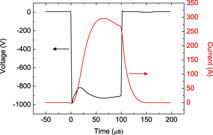Crossref Citations
This article has been cited by the following publications. This list is generated based on data provided by
Crossref.
Pedersen, Henrik
Larsson, Petter
Aijaz, Asim
Jensen, Jens
and
Lundin, Daniel
2012.
A novel high-power pulse PECVD method.
Surface and Coatings Technology,
Vol. 206,
Issue. 22,
p.
4562.
Oks, Efim M.
and
Anders, André
2012.
Boron-rich plasma by high power impulse magnetron sputtering of lanthanum hexaboride.
Journal of Applied Physics,
Vol. 112,
Issue. 8,
Brenning, N.
and
Lundin, D.
2012.
Alfvén's critical ionization velocity observed in high power impulse magnetron sputtering discharges.
Physics of Plasmas,
Vol. 19,
Issue. 9,
Samuelsson, Mattias
Jensen, Jens
Helmersson, Ulf
Hultman, Lars
and
Högberg, Hans
2012.
ZrB2 thin films grown by high power impulse magnetron sputtering from a compound target.
Thin Solid Films,
Vol. 526,
Issue. ,
p.
163.
Stranak, Vitezslav
Herrendorf, Ann-Pierra
Drache, Steffen
Cada, Martin
Hubicka, Zdenek
Bogdanowicz, Robert
Tichy, Milan
and
Hippler, Rainer
2012.
Plasma diagnostics of low pressure high power impulse magnetron sputtering assisted by electron cyclotron wave resonance plasma.
Journal of Applied Physics,
Vol. 112,
Issue. 9,
Gudmundsson, J. T.
Brenning, N.
Lundin, D.
and
Helmersson, U.
2012.
High power impulse magnetron sputtering discharge.
Journal of Vacuum Science & Technology A: Vacuum, Surfaces, and Films,
Vol. 30,
Issue. 3,
Kozák, Tomáš
and
Vlček, Jaroslav
2012.
Effect of voltage pulse characteristics on high-power impulse magnetron sputtering of copper.
Plasma Sources Science and Technology,
Vol. 22,
Issue. 1,
p.
015009.
Alami, Jones
2013.
Enhanced ionized sputtering in HIPIMS.
Vakuum in Forschung und Praxis,
Vol. 25,
Issue. 5,
p.
19.
Zhang, Xiaopeng
Zhu, Jiaqi
Zhang, Lixia
Han, Jiecai
and
Du, Shanyi
2013.
Low-temperature crystallization and hardness enhancement of alumina films using the resputtering technique.
Journal of Non-Crystalline Solids,
Vol. 362,
Issue. ,
p.
34.
Magnfält, D
Elofsson, V
Abadias, G
Helmersson, U
and
Sarakinos, K
2013.
Time-domain and energetic bombardment effects on the nucleation and coalescence of thin metal films on amorphous substrates.
Journal of Physics D: Applied Physics,
Vol. 46,
Issue. 21,
p.
215303.
Kozák, Tomáš
Vlček, Jaroslav
and
Kos, Šimon
2013.
Transport and ionization of sputtered atoms in high-power impulse magnetron sputtering discharges.
Journal of Physics D: Applied Physics,
Vol. 46,
Issue. 10,
p.
105203.
Hubička, Z.
Kment, Š.
Olejníček, J.
Čada, M.
Kubart, T.
Brunclíková, M.
Kšírová, P.
Adámek, P.
and
Remeš, Z.
2013.
Deposition of hematite Fe2O3 thin film by DC pulsed magnetron and DC pulsed hollow cathode sputtering system.
Thin Solid Films,
Vol. 549,
Issue. ,
p.
184.
Čapek, J
Hála, M
Zabeida, O
Klemberg-Sapieha, J E
and
Martinu, L
2013.
Deposition rate enhancement in HiPIMS without compromising the ionized fraction of the deposition flux.
Journal of Physics D: Applied Physics,
Vol. 46,
Issue. 20,
p.
205205.
Bolvardi, Hamid
Emmerlich, Jens
Mráz, Stanislav
Arndt, Mirjam
Rudigier, Helmut
and
Schneider, Jochen M.
2013.
Low temperature synthesis of Mo2BC thin films.
Thin Solid Films,
Vol. 542,
Issue. ,
p.
5.
Olejníček, J.
Hubička, Z.
Kment, Š.
Čada, M.
Kšírová, P.
Adámek, P.
and
Gregora, I.
2013.
Investigation of reactive HiPIMS+MF sputtering of TiO2 crystalline thin films.
Surface and Coatings Technology,
Vol. 232,
Issue. ,
p.
376.
Bagcivan, N.
Bobzin, K.
Grundmeier, G.
Wiesing, M.
Ozcan, O.
Kunze, C.
and
Brugnara, R.H.
2013.
Influence of HPPMS pulse length and inert gas mixture on the properties of (Cr,Al)N coatings.
Thin Solid Films,
Vol. 549,
Issue. ,
p.
192.
Vitelaru, Catalin
Lundin, Daniel
Brenning, Nils
and
Minea, Tiberiu
2013.
Plasma reactivity in high-power impulse magnetron sputtering through oxygen kinetics.
Applied Physics Letters,
Vol. 103,
Issue. 10,
Barker, Clara M.
Lewin, Erik
and
Patscheider, Jörg
2013.
Modified high power impulse magnetron sputtering process for increased deposition rate of titanium.
Journal of Vacuum Science & Technology A: Vacuum, Surfaces, and Films,
Vol. 31,
Issue. 6,
Lundin, Daniel
and
Pedersen, Henrik
2013.
High Power Pulsed Plasma Enhanced Chemical Vapor Deposition: A Brief Overview of General Concepts and Early Results.
Physics Procedia,
Vol. 46,
Issue. ,
p.
3.
Bagcivan, N.
Bobzin, K.
and
Theiß, S.
2013.
(Cr1−xAlx)N: A comparison of direct current, middle frequency pulsed and high power pulsed magnetron sputtering for injection molding components.
Thin Solid Films,
Vol. 528,
Issue. ,
p.
180.
